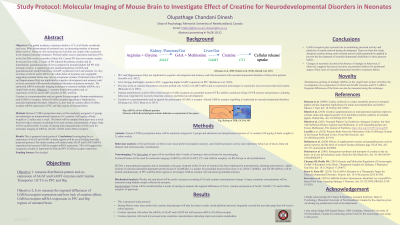Back

Objectives: The global incidence of preterm births is 11% of all births worldwide each year. With advancement of perinatal care, an increasing number of preterm babies survive. However, this increasing survival does not couple with a reduction in the impaired neurodevelopment. Preterm babies receive parenteral nutrition (PN) in the first few weeks to months of their life. Current PN does not contain creatine. In my previous work, 2-weeks of PN reduced the plasma creatine and its intermediate, guanidinoacetate (GAA) compared to neonatal piglets fed PN with premade creatine. L-arginine:glycine amidinotransferase (AGAT) and guanidinoacetate methyltransferase (GAMT) synthesize GAA and creatine. In-vitro activities of AGAT and GAMT in the whole brain of neonates were negligible suggesting neonatal brains may rely on exogenous creatine. Prefrontal cortex (PFC) and hippocampus (Hip) are implicated in cognitive development and memory such as those associated with neurodevelopmental disorders of preterm neonates. We optimized mRNA molecular imaging technique to measure multiple mRNAs in a single brain section. Objective 1: measure distribution pattern and co-expression of AGAT and GAMT enzymes in PFC and Hip.
Creatine is a neurotransmitter and an agonist for postsynaptic Gamma-aminobutyric acid (GABA) a receptor. Altered GABAa receptor signalling is implicated in neurodevelopmental disorders. Objective 2: how lack of creatine affects GABAa receptor mRNA expression in PFC and Hip regions of neonatal brain.
Methods:
Methods: Sixteen C57BL6 postpartum dams will be randomly assigned to 2 groups and administer an intraperitoneal injection of 1) creatine (160 mg/kg of body weight) or 2) saline once a week. The blood will be sampled from pups once a week from tail snip to measure circulating GAA and creatine concentrations of pups. Pups will be sacrificed after 4 weeks of nursing and extracted brains will be used for molecular imaging of mRNAs (AGAT, GAMT and GABAa receptor).
Results: This is proposed study protocol.
Conclusions: Investigating the co-expression of AGAT and GAMT in brain regions will be novel finding from this proposed protocol. Pre-made creatine will reduce brain AGAT and GAMT mRNA expression but increase GABAa receptor mRNA expression. This will suggest that exogenous creatine is important for Hip and PFC GABAa receptor expression.
Funding Sources: Not decided
Protocols
(PO28-10-22) Study Protocol: Molecular Imaging of Mouse Brain to Investigate Effect of Pre-made Creatine for Neurodevelopmental Disorders in Neonates

- OD
Olupathage C. Dinesh, PhD
– POSTDOCTORAL RESEARCHER, Memorial University of Newfoundland, ST. JOHN'S, Newfoundland and Labrador, Canada
Presenting Author(s)
Disclosure(s):
Olupathage C. Dinesh, PhD: No relevant financial relationship(s) with ineligible companies to disclose.
Objectives: The global incidence of preterm births is 11% of all births worldwide each year. With advancement of perinatal care, an increasing number of preterm babies survive. However, this increasing survival does not couple with a reduction in the impaired neurodevelopment. Preterm babies receive parenteral nutrition (PN) in the first few weeks to months of their life. Current PN does not contain creatine. In my previous work, 2-weeks of PN reduced the plasma creatine and its intermediate, guanidinoacetate (GAA) compared to neonatal piglets fed PN with premade creatine. L-arginine:glycine amidinotransferase (AGAT) and guanidinoacetate methyltransferase (GAMT) synthesize GAA and creatine. In-vitro activities of AGAT and GAMT in the whole brain of neonates were negligible suggesting neonatal brains may rely on exogenous creatine. Prefrontal cortex (PFC) and hippocampus (Hip) are implicated in cognitive development and memory such as those associated with neurodevelopmental disorders of preterm neonates. We optimized mRNA molecular imaging technique to measure multiple mRNAs in a single brain section. Objective 1: measure distribution pattern and co-expression of AGAT and GAMT enzymes in PFC and Hip.
Creatine is a neurotransmitter and an agonist for postsynaptic Gamma-aminobutyric acid (GABA) a receptor. Altered GABAa receptor signalling is implicated in neurodevelopmental disorders. Objective 2: how lack of creatine affects GABAa receptor mRNA expression in PFC and Hip regions of neonatal brain.
Methods:
Methods: Sixteen C57BL6 postpartum dams will be randomly assigned to 2 groups and administer an intraperitoneal injection of 1) creatine (160 mg/kg of body weight) or 2) saline once a week. The blood will be sampled from pups once a week from tail snip to measure circulating GAA and creatine concentrations of pups. Pups will be sacrificed after 4 weeks of nursing and extracted brains will be used for molecular imaging of mRNAs (AGAT, GAMT and GABAa receptor).
Results: This is proposed study protocol.
Conclusions: Investigating the co-expression of AGAT and GAMT in brain regions will be novel finding from this proposed protocol. Pre-made creatine will reduce brain AGAT and GAMT mRNA expression but increase GABAa receptor mRNA expression. This will suggest that exogenous creatine is important for Hip and PFC GABAa receptor expression.
Funding Sources: Not decided

.png)
